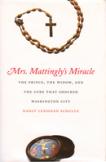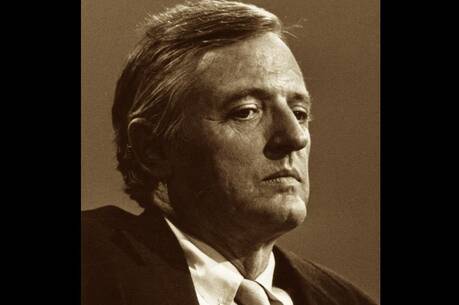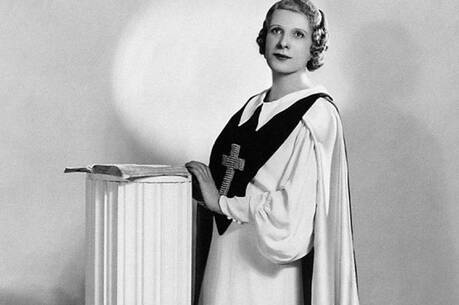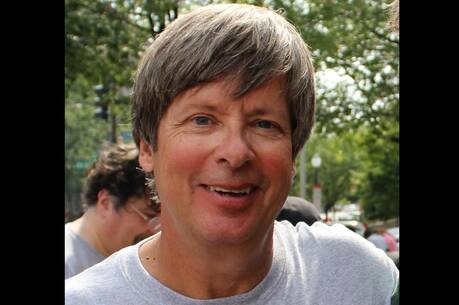Tragedy and Grace
This is the true story of Ann Mattingly (1784-1855), a Washington, D.C., socialite who allegedly received a long-distance cure, and a charismatic Austrian priest, Prince Alexander Hohenlohe (1777-1849), an acclaimed miracle worker.
Mrs. Mattingly, in fact, received two miracles. The first—and more dramatic—was a cure for seemingly end-stage breast cancer, which was attributed to the prince’s prayer formulary and intercession. Skeptics point out, however, that the prescribed Hohenlohe protocol called for him to celebrate Mass simultaneously with the priests in Mrs. Mattingly’s sickroom. This may not have actually been the case, since the prince was traveling at the time. Nancy Lusignan Shultz opines, “It is likely that the miracle occurred without the prince’s knowledge or participation.”
The second miracle, the healing of a gangrenous foot six years later, was attributed to her personal devotion to the Virgin Mary. Both events are well-documented and verified by ecclesiastical and civil authorities. As to the validity of the miracles, Schulz writes:
Having spent a decade examining the evidence, I believe that something extraordinary did happen in Washington city nearly two centuries ago…. How this happened, though, and whether the explanation is natural or supernatural, pushes deep into the realm of faith. This book does not try to guide you there.
Schultz is chairperson of the English department at Salem State University, Mass. In the course of the book Schultz presents the major players involved in Mrs. Mattingly’s life and deftly weaves the story within the context of the social and religious issues confronting the early 19th-century American Catholic Church.
Ann Mattingly was a woman of deep faith. Her family was one of the oldest Catholic families in Maryland. At the time of her first cure, March 12, 1824, she was living with her brother, Captain Thomas Carbery, mayor of Washington, D.C. The healing made Ann a celebrity. The publicity that her cure garnered, however, was not welcomed by all. As Schultz tells it, the incident unveiled a deep tension that existed in American Catholicism between rationalists, who were more solicitous to “the humanistic tradition of the French,” and continental romanticists, who emphasized a more sacramental view of reality.
The former group was represented by some Anglo-Jesuits and the more Gallicanized Sulpicians. They believed their Enlightenment approach would make Catholicism more acceptable in the largely Protestant nation. The latter group was composed of continental Jesuits, who eventually gained hegemony in the American church. In the minds of some, the ascendancy of sentimentalism marginalized the church from the American religious mainstream for the next 150 years. Schultz, however, points out that “for the Catholic clergy involved in debates over the miracle, very few of their differences had to do with faith and belief. They were far more concerned with how reception of the miracle would affect the developing American Church.” Schultz also cites Rome’s concerns both for the authenticity of the miracle and for the pope’s sensitivity to American political culture.
Prince Hohenlohe is an enigmatic figure, credited with hundreds of miracles throughout Europe. Yet there was always a taint of suspicion regarding his character. Accusations of being a dandy, reported incidents of disobedience to his superiors and rumors of womanizing were leveled against him. Schultz quotes one of Hohenlohe’s early biographers, “To his enemies, the prince was ‘an itinerant Thaumaturgist, of blasted character.’ To admirers, he seemed to lead a sound life, though some negative accusations may have rung true.”
Some of the details of Mrs. Mattingly’s life—for example, the reasons for her separation from her husband and alienation from her son—are speculative on Schultz’s part but probable based on the available data. She presents the possibility that both suffered from a form of Lou Gehrig’s disease (Amyotrophic lateral sclerosis, or ALS) and chronic alcoholism. She also ventures that Mrs. Mattingly’s son was estranged from the family because of a miscegenous marriage presided over by a Methodist minister. Both would have been taboo in Mrs. Mattingly’s world.
From Schultz’s research Mrs. Mattingly seems to have led an exemplary life. She placed herself under spiritual direction, maintained penitential disciplines and spent a good deal of time in prayer at Georgetown’s Visitation Monastery, where the second miracle occurred. She also had a great desire to enter the monastery as a nun, but this ran counter to the advice of her spiritual director. Schultz posits the possibility that she may have achieved the unitive stage of the spiritual life. This assertion is bolstered by this extract from one of Mrs. Mattingly’s letters to her spiritual director:
Yet I feel a longing desire to be united to him, & who can express his infinite goodness mercy & love when on receiving him he is pleased as it was to overpower me with a sweetness inexpressible, it appears & really leaves in my mouth a licquor of sweetness which I swallow as if poured in my mouth by large droughts. My hands face & vail is [sic] sometimes perfumed with the smell which to my heart and soul is inexpressible.
Schultz’s feminist critique of Catholicism during the era is based on, as she puts it, “the graphic descriptions of the gruesome illness [that] mark Mrs. Mattingly’s suffering as extraordinary; …[in] her lack of complaint and offering up of her suffering, she becomes the ideal symbol of Catholic womanhood, a ‘victim soul.’” The author’s analysis of this, however, fails to note Catholicism’s balanced view of reason and sentimentality or the feminine and masculine contributions encapsulated in the events portrayed. A question not broached by Schultz is why Ann Mattingly has never been proposed for sainthood.
Mrs. Mattingly’s Miracle provides the reader an invaluable insight into early American Catholicism. More important, Schultz succeeds in exposing the roots of an internecine battle between advocates for a publicly engaged church and those who prefer a more separatist mystical model.
This article also appeared in print, under the headline “Tragedy and Grace,” in the August 29, 2011, issue.








